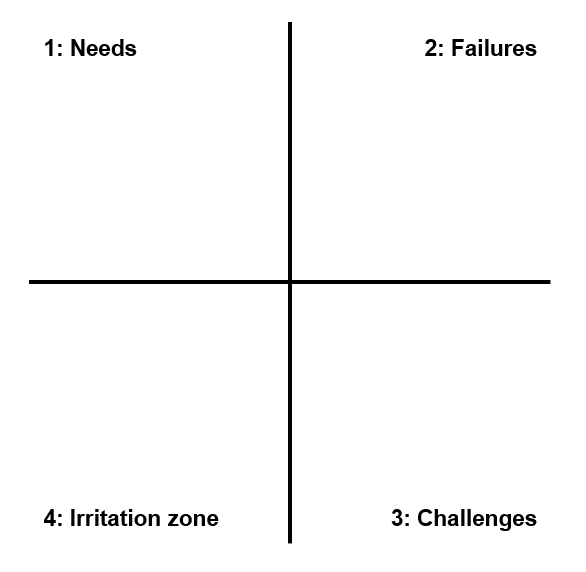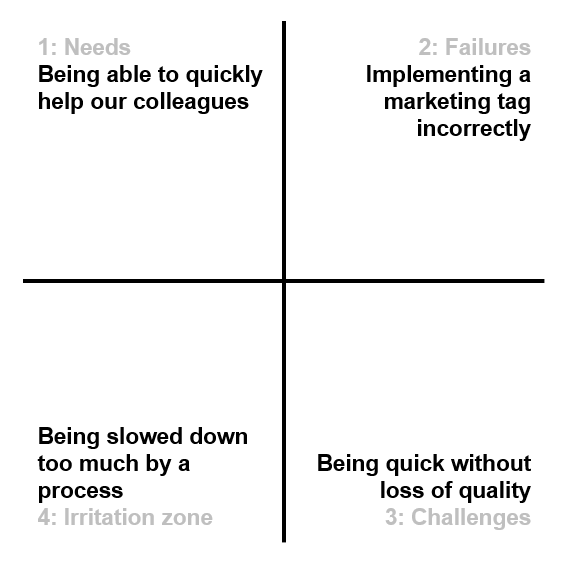There is a lot of discussion online about experimentation cultures. Talks on how to embrace experimentation within your company. A lot of these talks revolve around processes to optimise a business with some form of continuous testing. But I think we often forget to apply similar techniques to ourselves and our teams.
When I read Google’s post on Quarterly Failure Reports back in 2017, I thought I could use their approach quite easily for the team I was working in. I decided to give it a go. And it turned out it was quite easy to adapt for team development purposes.
In this post, I will share how to adopt it in three easy-to-use steps. I hope it may help you improve your team.
1: Collect your failures
The first step is easy: your team has to start collecting failures. In the office, we used to write any failure we made on a post-it note. Each note included a few words describing the failure and the name of the person who wrote it. We made sure to just write down our own individual failures. It helped us focus on the improving the overall quality of our team (instead of pointing fingers to others). We put each note into ‘the failure jar’.
As a digital alternative, you can have people collect their failures in any format they want. Just make sure that they can (virtually) bring them to the Quarterly Failure Report session.
2: The Quarterly Failure Report session for team development
This is where the good stuff happens. In a team-focused Quarterly Failure Report, each team member shares their failures, mistakes, and other missteps. The important part here is that we want to learn from the mistakes. How do we get from failures to learnings?
The Quarterly Failure Report grid
With our team, we used a grid with four quadrants to process the failures:

We drew the grid on a whiteboard at the start of the session.
Every failure we discussed is put in the 2nd quadrant, the ‘failure’ quadrant. After someone shares the failure, with a brief elaboration, we pose a simple question:
What need caused this failure?
We put the answer to that question in quadrant 1, the ‘needs’ quadrant. Next up is quadrant 3: challenges. Here we answer the following question:
How can we meet the need without causing the failure?
The final quadrant to discuss is quadrant 4: ‘the irratation zone’. This quadrant includes anything that a person, or the team as a whole, doesn’t want to become. It is often what happens when something that helps with a challenge gets too much focus.
Example
Here’s an example to make the quadrant easier to understand. Part of the team’s responsibility was to place marketing tags (little pieces of code that collect data for advertising purposes) on websites. We mostly did so for our internal marketing teams. Sometimes, a tag was placed incorrectly. A failure! Because of the failure, data was not collected or collected incorrectly.
The failure is clear: placing a marketing tag incorrectly. What was the need that cause this failure? We probably wanted to help our colleagues as quickly as possible. What is our challenge? To place marketing tags quickly but without issues, e.g. by sticking to a quality control process. But we don’t want to become slow in helping our colleagues because of a process (the irritation zone). We probably need to define a speedy quality control process to reduce failures and minimise impact on speed.
Here’s what it would look like in the four quadrants:

During the session, some failures may feel similar to others. If you think this is the case, discuss it with your team members. If they agree, group it to one of the failures already listed on the grid.
For a digital session, you can use a shared Google Slides or PowerPoint deck (or similar technology) to show the grid as it gets filled.
3: Process the outcome
A session like this gives you a lot of valuable knowledge. You know what tends to go wrong, but you also know why that tends to happen, what your team’s needs are, and what things are in the irritation zone. Pretty good stuff. And just too good to leave laying around. That’s why you should process it.
Back then, I used the outcome to write a draft for the team’s vision for the way of working. And it’s really not that hard once you know all the needs and challenges the team faces.
Keep on celebrating your failures
It’s easy to tell your employees that failing is okay. It’s even better to help them view their failures as valuable moments of development. A Quarterly Failure Report for team development is a way to change how people view failures. It can help foster a true ‘failures are okay, as long as you learn from them’ mindset. Something that I think is valuable in any company culture.
